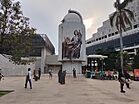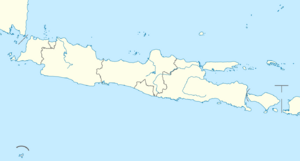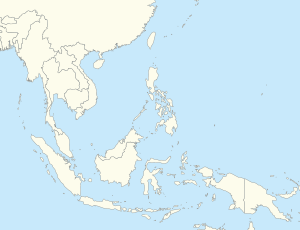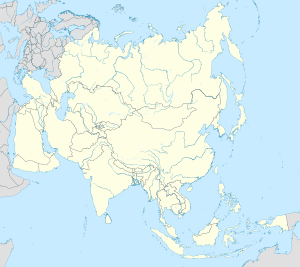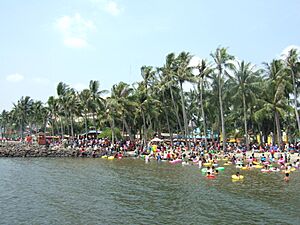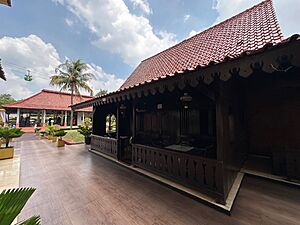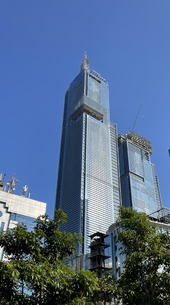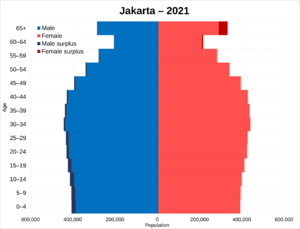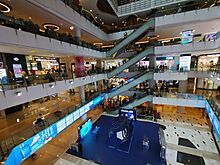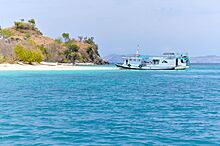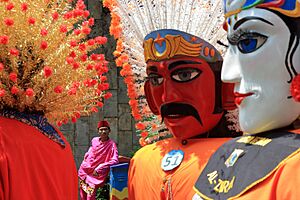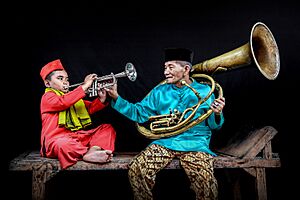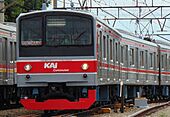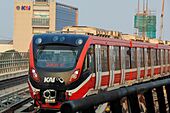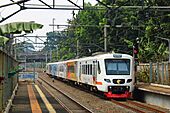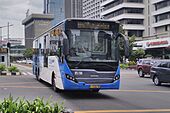Jakarta facts for kids
Quick facts for kids
Jakarta
|
|||
|---|---|---|---|
| Special Capital Region of Jakarta Daerah Khusus Ibukota Jakarta |
|||
|
Skyline of the Golden Triangle of Jakarta
Car free day in Bundaran HI
Merdeka Palace
National Museum of Indonesia
Ismail Marzuki Park
Jakarta Old Town
Flames on Monas
|
|||
|
|||
| Nicknames: | |||
| Motto(s): | |||
| Country | |||
| Region | Java | ||
| Administrative cities and regencies |
List
|
||
| Originated | 5th CE (first settlement) | ||
| Founded | 22 June 1527 | ||
| Established as Batavia | 30 May 1619 | ||
| City status | 4 March 1621 | ||
| Province status | 28 August 1961 | ||
| Capital | Central Jakarta (de facto) |
||
| Government | |||
| • Type | Special administrative area | ||
| • Body | Special Capital Region of Jakarta Provincial Government | ||
| Area | |||
| • Special Capital Region | 660.982 km2 (255.207 sq mi) | ||
| • Urban | 3,546 km2 (547.16 sq mi) | ||
| • Metro | 7,076.31 km2 (2,732.18 sq mi) | ||
| Area rank | 38th in Indonesia | ||
| Elevation | 8 m (26 ft) | ||
| Population
(2023)
|
|||
| • Special Capital Region | 11,350,328 | ||
| • Rank | 6th in Indonesia | ||
| • Density | 17,171.917/km2 (44,475.06/sq mi) | ||
| • Urban | 35,386,000 | ||
| • Urban density | 9,979.1/km2 (64,672.1/sq mi) | ||
| • Metro | 32,594,159 | ||
| • Metro density | 4,606.095/km2 (11,929.732/sq mi) | ||
| Demonym(s) | Jakartan | ||
| Demographics | |||
| • Ethnic groups |
List
|
||
| • Religion (2022) |
List
|
||
| GDP | |||
| • City | Rp 3,442.98 trillion US$ 225.88 billion Int$ 724.01 billion (PPP) |
||
| • Per capita | Rp 322.62 million US$ 21,166 Int$ 67,842 (PPP) |
||
| • Metro | Rp 6,404.70 trillion US$ 420.192 billion Int$ 1.346 trillion (PPP) |
||
| Time zone | UTC+07:00 (Indonesia Western Time) | ||
| Postal codes |
10110–14540, 19110–19130
|
||
| Area code(s) | +62 21 | ||
| ISO 3166 code | ID-JK | ||
| Vehicle registration | B | ||
| HDI (2023) | |||
Jakarta is the capital and largest city of Indonesia. It is located on the northwest coast of Java, which is the world's most populated island. Jakarta is also the biggest city in Southeast Asia. It is a special capital region, like a province, and is bordered by West Java and Banten. The city faces the Java Sea to the north.
Jakarta is a very important place for Indonesia's economy, culture, and politics. Even though it's the smallest province in Indonesia by land area, its surrounding metropolitan area is huge. This area, called Greater Jakarta, includes nearby cities like Bogor, Depok, Tangerang, South Tangerang, and Bekasi. Over 32 million people live here, making it one of the largest urban areas in the world. Many people move to Jakarta for jobs and a better life, making it a mix of many different cultures.
Jakarta is one of the oldest cities in Southeast Asia that has always been lived in. It started as Sunda Kelapa in the 4th century and became an important trading port. Later, it was the capital of the Dutch East Indies and was known as Batavia. Today, Jakarta is a major global city and home to important financial groups and many companies.
However, Jakarta faces big challenges like fast growth, pollution, traffic, and flooding. Parts of North Jakarta are sinking every year, making floods worse. Because of this, the government plans to move Indonesia's capital to a new city called Nusantara on the island of Borneo. But the government also plans to spend a lot of money to protect Jakarta from sinking and improve the city.
Contents
City's Name and History
Jakarta has had many names over time. Each name tells a bit about its past.
How Jakarta Got Its Name
- Sunda Kelapa (13th century–1527): This was the first name, meaning 'Coconut of Sunda'. It was a key harbor for the Sunda Kingdom.
 Jayakarta (1527–1619): After Muslim troops won a battle against the Portuguese in 1527, the city was renamed Jayakarta. This name comes from Sanskrit words meaning 'victorious deed' or 'complete victory'.
Jayakarta (1527–1619): After Muslim troops won a battle against the Portuguese in 1527, the city was renamed Jayakarta. This name comes from Sanskrit words meaning 'victorious deed' or 'complete victory'. Batavia (1619–1949): When the Dutch took control in 1619, they renamed it Batavia. This name was after an old Germanic tribe. The city was also called 'Queen of the Orient' because of its beautiful canals and buildings.
Batavia (1619–1949): When the Dutch took control in 1619, they renamed it Batavia. This name was after an old Germanic tribe. The city was also called 'Queen of the Orient' because of its beautiful canals and buildings. Djakarta (1942–1972): During the Japanese occupation, the city was called Jakarta Special City. After the Japanese left, it became Djakarta.
Djakarta (1942–1972): During the Japanese occupation, the city was called Jakarta Special City. After the Japanese left, it became Djakarta. Jakarta (1972–present): The spelling was officially changed to Jakarta in 1972.
Jakarta (1972–present): The spelling was officially changed to Jakarta in 1972.
Jakarta's Early Days

The area where Jakarta is now was home to ancient cultures. In the 4th century, it was part of the Tarumanagara kingdom. Later, it became part of the Hindu Sunda Kingdom. By the 14th century, the port of Sunda Kelapa was a very important trading spot.
In 1513, the first European ships, from Portugal, arrived looking for spices. The Sunda Kingdom made a deal with the Portuguese to build a port. But in 1527, a military leader named Fatahillah attacked and took over Sunda Kelapa. He renamed it Jayakarta. This city then became a major trading center for the Banten Sultanate.
Dutch ships arrived in 1596. The Dutch and English both tried to set up trading posts here.
The Colonial Period
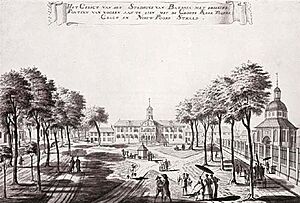
In 1619, the Dutch defeated their rivals and took control, renaming the city Batavia. Many people from different places, like Chinese and Arabs, came to live and work in the city. This led to a big increase in population.
Later, the city started to grow southwards. New areas like Menteng were built with wide roads and green spaces. By 1930, Batavia had over 500,000 people. In 1942, during World War II, the Japanese took over and renamed the city Jakarta. After the war, it went back to being called Batavia until Indonesia became fully independent in 1949.
Becoming the Capital of Indonesia

After World War II, Indonesia declared its independence in 1945. Jakarta officially became the capital of Indonesia in 1950.
In the 1960s, President Sukarno wanted Jakarta to be a great international city. He started many big projects, building new roads, monuments, and stadiums. These included the National Monument (Monas) and the Gelora Bung Karno Stadium.
In 1966, Jakarta was given a special status, making it like a province. This meant it had its own governor. The city continued to grow and develop, attracting more people and businesses.
In recent years, the Indonesian government decided to move the capital to a new city called Nusantara. This decision was made to help solve some of Jakarta's big problems, like overcrowding and flooding. However, the government also plans to invest a lot in Jakarta to make it a better city for everyone.
Jakarta's Geography and Environment
Where Jakarta Is Located
Jakarta covers about 661 square kilometers. Its larger metropolitan area, called Greater Jakarta, is much bigger, stretching into the nearby provinces of West Java and Banten.
The city is on the northwest coast of Java, right where the Ciliwung River meets Jakarta Bay and the Java Sea. The northern part of Jakarta is flat and low, with some areas even below sea level. This makes it prone to flooding. The southern parts of the city are hillier. Jakarta is one of only two capital cities in Asia that are in the Southern Hemisphere.
Rivers and Flooding Challenges
Thirteen rivers flow through Jakarta, starting from the highlands to the south and flowing north into the Java Sea. The Ciliwung River divides the city into western and eastern parts. These rivers, along with heavy rains during the wet season and blocked drains, often cause flooding in Jakarta.
A major problem for Jakarta is that it is sinking. Some northern coastal areas are sinking up to 20 centimeters (about 8 inches) each year. This makes flooding worse. To help with this, a large sea wall, called the Giant Sea Wall Jakarta, is being built around Jakarta Bay. This wall will have pumps and special areas to hold water, protecting the city from the sea.
One main reason Jakarta is sinking is because too much groundwater is being pumped out, often illegally. Many tall buildings and factories use groundwater instead of city water. Stopping this pumping and finding other water sources could help slow down the sinking.
Jakarta also has a problem with air pollution, especially during the dry season from August to December. The dry air traps pollutants, making the air quality poor.
City Design and Famous Places
Jakarta's Architecture
Jakarta's buildings show a mix of different styles from its history. You can see influences from Malay, Sundanese, Javanese, Arabic, Chinese, and Dutch cultures. For example, traditional Betawi houses are made of wood and have roofs similar to the Javanese Joglo style.
Many old buildings from the Dutch colonial period can still be seen, especially in Jakarta Old Town and Central Jakarta. These buildings were designed in styles like Neo-Renaissance and later, Art Deco. The Menteng area, built in the 1910s, was designed to be a healthy and ideal place for middle-class families.
After Indonesia became independent, new buildings were designed to show national pride. The National Monument (Monas) is a great example of this. In the 21st century, Jakarta has seen a huge building boom. The Golden Triangle of Jakarta is a fast-growing business area with many tall skyscrapers. Jakarta has more buildings over 150 meters tall than any other city in Southeast Asia.
Important Landmarks
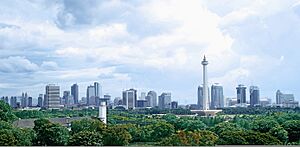
Most of Jakarta's famous landmarks and statues were planned in the 1960s by President Sukarno. He wanted the city to be a symbol of a strong new nation.
- The most famous landmark is the National Monument (Monas). It's a 132-meter tall obelisk in the middle of Merdeka Square.
- Near Monas, you can find the Arjuna Wijaya chariot statue and fountain.
- Further south, the Selamat Datang monument (Welcome Monument) stands in the center of the Hotel Indonesia roundabout.
- Other important landmarks include the Istiqlal Mosque (the largest mosque in Southeast Asia), Jakarta Cathedral, and the Immanuel Church.
- The old Batavia Stadhuis (City Hall) in Jakarta Old Town is also a key landmark.
- The Autograph Tower is the tallest building in Indonesia, standing at 382.9 meters.
- The newest landmark is the Jakarta International Stadium.
Many statues in Jakarta honor Indonesian national heroes and important events, like the West Irian Liberation Monument and the statues of Diponegoro and Kartini.
Parks and Green Spaces

Jakarta has many parks and public spaces where people can relax and enjoy nature.
- Merdeka Square is a huge field in the city center, home to the Monas. It has a deer park and 33 trees representing Indonesia's provinces.
- Ancol Dreamland is a large tourism area by the bay in North Jakarta, with many attractions.
- Lapangan Banteng is a park in Central Jakarta, home to the West Irian Liberation Monument.
- Taman Mini Indonesia Indah (Miniature Park of Indonesia) in East Jakarta has mini-parks showing different regions of Indonesia.
- Suropati Park in Menteng is known for its modern statues made by artists from Southeast Asian countries.
- Menteng Park was built on the site of an old football stadium.
- Kalijodo Park is a new park in Penjaringan with international-standard skateboarding facilities.
- The Muara Angke Wildlife Sanctuary and Angke Kapuk Nature Tourism Park protect mangrove forests.
- Ragunan Zoo Park in South Jakarta is the largest park in Jakarta and one of the oldest and biggest zoos in the world.
- Glodok is Jakarta's Chinatown, a lively area with a long history.
- The National Museum of Indonesia is a great place to learn about Indonesia's history and cultures.
- Setu Babakan is a lake surrounded by a Betawi cultural village, where you can experience local traditions.
- UI Forest is the largest urban forest in Jakarta.
- The National Library of Indonesia holds a vast collection of books and historical documents.
- Gelora Bung Karno Sports Complex is a huge sports center used for many activities.
- Pantai Indah Kapuk (PIK) is a modern area with large houses, businesses, and tourist spots, including a beautiful Chinese Pagoda.
Climate and Weather
Jakarta has a tropical monsoon climate. This means it has a wet season and a dry season.
Seasons in Jakarta
- The wet season lasts from October to May.
- The dry season is from June to September, with less rain.
The city gets the most rain in January and February. August is usually the driest month.
Temperature and Rainfall
Average temperatures in Jakarta are quite high. During the day, it's usually around 32°C (90°F), dropping to about 24°C (75°F) in the evening. It can get even hotter on some days.
Flooding and thunderstorms are common, especially during the wet season. This is partly because of the way winds bring moisture over Java Island.
The sea temperature is warm all year round, usually between 26.5°C (80°F) and 29.5°C (85°F).
| Climate data for Jakarta | |||||||||||||
|---|---|---|---|---|---|---|---|---|---|---|---|---|---|
| Month | Jan | Feb | Mar | Apr | May | Jun | Jul | Aug | Sep | Oct | Nov | Dec | Year |
| Average sea temperature °C (°F) | 28.0 (82.0) |
28.0 (82.0) |
29.0 (84.0) |
30.0 (86.0) |
30.0 (86.0) |
29.0 (84.0) |
29.0 (84.0) |
29.0 (84.0) |
29.0 (84.0) |
29.0 (84.0) |
29.0 (84.0) |
29.0 (84.0) |
29.0 (84.0) |
| Mean daily daylight hours | 12.0 | 12.0 | 12.0 | 12.0 | 12.0 | 12.0 | 12.0 | 12.0 | 12.0 | 12.0 | 12.0 | 12.0 | 12.0 |
| Average Ultraviolet index | 13 | 13 | 13 | 13 | 11 | 10 | 10 | 12 | 13 | 13 | 13 | 13 | 12 |
| Source: Weather Atlas | |||||||||||||
People and Culture
Who Lives in Jakarta?
Jakarta is a very diverse city, with people from all over Indonesia. Many come to find jobs and a better life. In 2023, the population was over 11 million people. The city's population has grown a lot over the years.
Jakarta doesn't have one main ethnic group. It's a mix of many different cultures.
| Ethnicity of Jakarta – 2010 Census | ||||
|---|---|---|---|---|
| Ethnicity | Percent | |||
| Javanese | 36.17% | |||
| Betawi | 28.29% | |||
| Sundanese | 14.61% | |||
| Chinese | 6.623% | |||
| Batak | 3.42% | |||
| Minang | 2.85% | |||
| Malay | 0.96% | |||
| Others | 7.06% | |||
The Betawi are the local people of Jakarta. They are a mix of many different groups who came to the city over centuries. They have intermarried with people of Chinese, Arab, and European backgrounds.
There's also a large Chinese community in Jakarta. They have lived here for a long time, especially in areas like Glodok (Jakarta's Chinatown). Many people from Sumatra, like the Batak and Minangkabau, also live in Jakarta.
Languages Spoken
Indonesian is the main language spoken in Jakarta. Many older people might also speak Dutch or Chinese. English is often used for communication, especially in business areas.
Each ethnic group also uses its own language at home, like Betawi, Javanese, and Sundanese. The Betawi language is a mix of Malay with words from Dutch, Portuguese, Sundanese, Javanese, Chinese, and Arabic. Many Betawi words are now part of Indonesian slang and are used across the country.
Chinese people in Jakarta mostly speak Indonesian and English. Older generations might speak Hokkien dialect or Mandarin. People from different parts of China have brought other dialects like Hakka and Teochew. Batak people often speak Indonesian, but older ones might use their native languages. Minangkabau people usually speak Minangkabau and Indonesian.
Education Opportunities
Jakarta has many schools and universities. The University of Indonesia (UI) is the biggest and oldest university in the country. There are also other public universities like Syarif Hidayatullah State Islamic University Jakarta and the State University of Jakarta. Many private universities are also located here.
Jakarta attracts students from all over Indonesia. For younger students, there are public, private, and international schools. Some well-known international schools include the British School Jakarta and the Jakarta Intercultural School.
Religions in Jakarta
| Religion in Jakarta (June 2024) | ||||
|---|---|---|---|---|
| Religion | Percent | |||
| Islam | 83.83% | |||
| Protestanism | 8.6% | |||
| Catholicism | 3.9% | |||
| Buddhism | 3.46% | |||
| Hinduism | 0.18% | |||
| Confucianism | 0.017% | |||
| Others | 0.013% | |||
Jakarta is a city with many different religions. Most people in Jakarta are Muslim. There are also many Protestants, Catholics, and Buddhists. Smaller groups of Hindus and Confucians also live in the city.
Many Islamic schools and organizations have their main offices in Jakarta. The Roman Catholic community has its main church, the Jakarta Cathedral, here. Jakarta also has the largest number of Buddhists on Java Island, mostly Chinese Indonesians. There are also Hindu communities, mainly from Bali and India.
- Places of worship
-
Immanuel's Church is a Protestant church and one of the oldest churches in Indonesia.
-
The Jakarta Cathedral, one of the oldest Catholic churches in Jakarta.
-
Vihāra Jakarta Dhammacakka Jaya, the first Theravāda Buddhist temple in Jakarta.
-
Kim Tek Ie, the oldest Confucian-Taoist-Mahāyāna Buddhist (Tridharma) temple in West Jakarta.
Economy and Fun Activities
Jakarta's Economy
| Jakarta GDP share by sector (2022) | ||||
|---|---|---|---|---|
| GDP share by sector | Percent | |||
| Service | 75.93% | |||
| Manufacturing | 12.28% | |||
| Other Industrial | 11.71% | |||
| Agriculture | 0.08% | |||
Indonesia has the largest economy in ASEAN, and Jakarta is its economic heart. Jakarta's economy relies heavily on services like banking and finance, and on manufacturing. Industries here include electronics, cars, and chemicals.
The main office of Bank Indonesia and the Indonesia Stock Exchange are in Jakarta. Many big Indonesian companies and international companies also have their headquarters here. Jakarta is a very important city for business in Southeast Asia.
The city's economy is growing fast. Many new buildings are being constructed, especially in the Golden Triangle of Jakarta business district. Jakarta is becoming one of the top cities in the world for real estate investment. However, the cost of living in Jakarta is also rising.
Shopping in Jakarta
Jakarta has a huge number of shopping malls, more than any other city. You can find many famous malls like Plaza Indonesia, Grand Indonesia, Plaza Senayan, and Pondok Indah Mall. These malls have international fashion brands and department stores.
Besides modern malls, Jakarta also has many traditional markets. Places like Tanah Abang, Senen, and Glodok are popular for different kinds of goods. You can even find antique items at Jalan Surabaya and gemstones at Rawabening Market.
Tourism and Fun Things to Do
Jakarta is a popular place for tourists, especially those from Indonesia. It's often the first stop for foreign visitors before they go to other famous places in Indonesia like Bali or Komodo Island. The city is also becoming a popular spot for international conferences and events.

Jakarta is working to attract more international tourists. The tourism industry brings a lot of money to the city.
Culture and Entertainment
Arts and Festivals
Jakarta is a mix of cultures from all over Indonesia. While the Betawi people are native to Jakarta, the city's culture includes many different languages and ethnic groups. Betawi culture has strong influences from Chinese and Arab traditions, seen in their food and wedding clothes.
Many festivals in Jakarta aim to preserve Betawi arts, with artists performing traditional shows. Jakarta has several places for performing arts, like Taman Ismail Marzuki and Gedung Kesenian Jakarta. You can also see traditional Indonesian art, like Wayang puppet shows and Gamelan music, at various venues.
The city hosts many arts and culture festivals and exhibitions throughout the year. These include film festivals, fashion weeks, and art fairs. The Jakarta Fair is a big annual event celebrating the city's anniversary, with trade shows, entertainment, and music. The Jakarta International Java Jazz Festival (JJF) is one of the largest jazz festivals in the world.
Foreign cultural centers in Jakarta, like the Confucius Institute (Chinese) and Goethe-Institut (German), also promote their cultures and languages.
Delicious Food

Jakarta offers all kinds of Indonesian cuisine. The local food is called Betawi cuisine, which is a mix of Malay, Chinese, Sundanese, Javanese, Indian, Arabic, and European flavors.
One famous Betawi dish is Soto Betawi, a rich and spicy soup with beef. Other popular Betawi foods include nasi uduk (mixed rice), kerak telor (spicy omelette), and gado-gado (salad with peanut sauce).
You can find Jakarta's food everywhere, from small street stalls called warung to fancy restaurants. Many traditional foods from other parts of Indonesia are also popular, like Padang restaurants and Warteg food stalls. Popular street foods include nasi goreng (fried rice), sate (skewered meats), and bakso (meatballs).
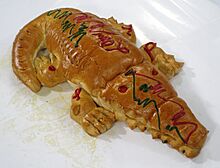
Some popular areas for street food are Jalan Sabang and Jalan Kendal. For Chinese street food, visit Jalan Pangeran and Petak Sembilan. The Little Tokyo area in Blok M has many Japanese restaurants.
Jakarta also has many trendy restaurants, cafes, and bars in areas like Menteng and Kemang. You can find global fast-food chains and local Indonesian brands. The city also offers a wide range of international cuisines, from Chinese and Japanese to Italian and Middle Eastern.
Sports and Recreation
Jakarta has hosted many big sports events, including the 1962 Asian Games and the 2018 Asian Games. It has also hosted the Southeast Asian Games multiple times.
The Senayan sports complex is a large area with many sports venues. It includes the Gelora Bung Karno Stadium for football, Istora Senayan for badminton, an aquatic arena, and tennis courts. The Jakarta International Stadium is the largest stadium in Indonesia.
Jakarta also has the Jakarta International Velodrome for cycling and the Jakarta International Equestrian Park for horse riding.
Every Sunday, Jakarta holds "Car-Free Days" on its main streets. From 6 am to 11 am, cars are not allowed, and people can walk, jog, bike, skateboard, and do other activities. You can see morning gymnastics, futsal games, and even on-street libraries.
Jakarta's most popular football club is Persija. The city also hosts the Jakarta Marathon every November, which attracts runners from all over the world. In 2022, Jakarta hosted its first Formula E electric car race.
Media and Entertainment
Jakarta is the center for most of Indonesia's national newspapers and television channels. Local newspapers like Pos Kota and Warta Kota cover city news. National newspapers like Kompas and Media Indonesia are also based here.
You can also find English-language newspapers like The Jakarta Post and Chinese and Japanese newspapers.
Jakarta has many radio stations, broadcasting on both FM and AM bands. Major national radio networks and local stations are based in the city.
Jakarta is home to Indonesia's public television station, TVRI, and many private national television networks like Metro TV and RCTI. Some local TV channels also broadcast in Jakarta.
City Services
Transportation in Jakarta
Jakarta has a busy transportation system. The city is working on a big project to improve its public transport. This includes building new train lines and improving bus services.
You can get around Jakarta using:
- KRL Commuterline: A commuter train system that connects Jakarta with its surrounding areas.
- Jakarta MRT: A modern subway system that runs through the city center.
- Jabodebek LRT and Jakarta LRT: Light rail transit systems that help people travel around.
- Soekarno–Hatta Airport Rail Link: A train that connects the city to the airport.
- Transjakarta: A bus rapid transit (BRT) system with dedicated lanes.
Healthcare Services
Jakarta has many hospitals and clinics, both public and private. In 2012, a program called 'Healthy Jakarta Card' was started to provide healthcare for everyone. This program is now part of a larger national healthcare system called Jaminan Kesehatan Nasional (JKN).
Government hospitals are good but can be crowded. There are also many private hospitals and clinics that offer healthcare services.
Water Supply
Two private companies provide piped water to Jakarta. Most of the water comes from a reservoir about 70 kilometers southeast of the city. However, many people in Jakarta still don't have access to piped water and rely on wells. The city is facing a challenge to provide clean water to all its residents.
International Connections
Global Partnerships
Jakarta is an important city for international relations. It hosts many foreign embassies. Jakarta is also the headquarters for the Association of Southeast Asian Nations (ASEAN), a group of countries in Southeast Asia.
Jakarta is part of several international networks, like the C40 Cities Climate Leadership Group, which focuses on climate action.
Sister Cities Around the World
Jakarta has "sister city" agreements with many cities around the world. These agreements help promote friendship and cooperation between cities. For example, Jakarta is a sister city with Casablanca in Morocco.
Here are some of Jakarta's sister cities:
 Bandar Seri Begawan, Brunei
Bandar Seri Begawan, Brunei Bangkok, Thailand
Bangkok, Thailand Beijing, China
Beijing, China Berlin, Germany
Berlin, Germany Casablanca, Morocco
Casablanca, Morocco East Jerusalem, Palestine
East Jerusalem, Palestine Hanoi, Vietnam
Hanoi, Vietnam Islamabad, Pakistan
Islamabad, Pakistan Istanbul, Turkey
Istanbul, Turkey Jeddah, Saudi Arabia
Jeddah, Saudi Arabia Kyiv, Ukraine
Kyiv, Ukraine Los Angeles, United States
Los Angeles, United States Manila, Philippines
Manila, Philippines Maputo, Mozambique
Maputo, Mozambique Moscow, Russia
Moscow, Russia Mumbai, India
Mumbai, India New York, United States
New York, United States Pyongyang, North Korea
Pyongyang, North Korea Seoul, South Korea
Seoul, South Korea Shanghai, China
Shanghai, China Tokyo, Japan
Tokyo, Japan
Jakarta also works with other cities and regions on special projects. For example, it partners with Rotterdam in the Netherlands to manage urban water, as both cities face similar flooding challenges.
See also
 In Spanish: Yakarta para niños
In Spanish: Yakarta para niños






